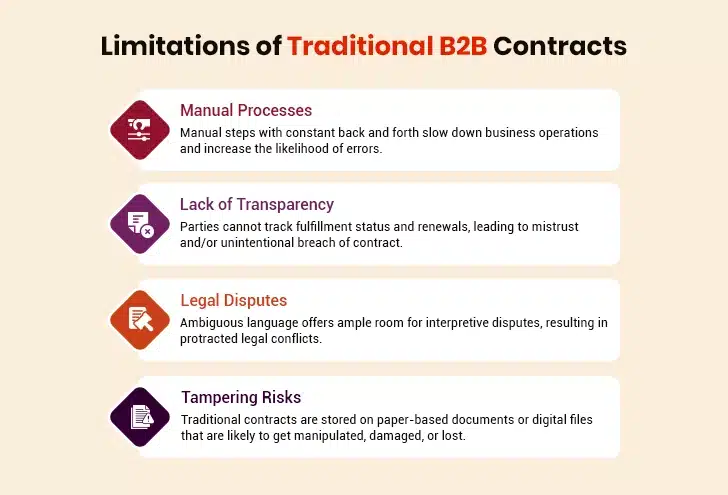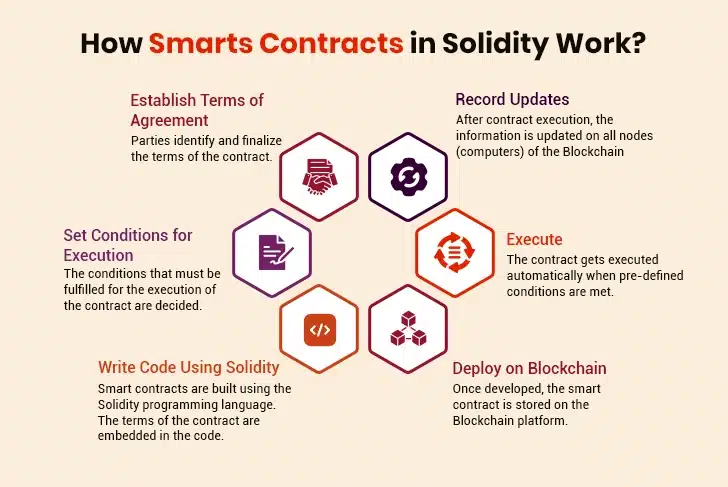Traditional B2B contracts are often bogged down by cumbersome paperwork and slow, manual approvals. Lengthy legal reviews create bottlenecks, wasting both time and money. These outdated processes need an upgrade. Smart contracts built with Solidity programming offer a viable solution.
Solidity is a specialized language for creating self-executing contracts on the Ethereum Blockchain. Here, the contract terms are embedded directly into the code. This feature eliminates middlemen and ensures tamper-proof transactions. Today, the DeFi ecosystem relies on Solidity to build decentralized exchanges. Businesses also use it to tokenize assets.
What sets Solidity apart for business relationships? It delivers transparency and traceability that traditional contracts cannot provide. The language supports features of object-oriented programming. This allows developers to build secure, modular contracts. Instead of static paper documents, Solidity creates dynamic protocols that execute automatically while maintaining security and trust.

Table of Contents
The Traditional B2B Contract Landscape: Key Challenges
Enter Solidity: The Engine of Trustworthy Automation
How Solidity-Based Smart Contracts Improve B2B Agreements
Real-Life B2B Use Cases for Solidity
Implementing with Confidence: Solidity Best Practices for B2B
The Traditional B2B Contract Landscape: Key Challenges

Until recently, the business world relied on paper-based contracts and digital documents. These old-school methods create more problems than they solve, turning simple agreements into administrative nightmares.
1. Slow and Error-Prone Manual Processes
B2B agreements involve many manual steps that slow down operations. Legal teams pass contract drafts back and forth multiple times. Each revision adds days or weeks to the timeline. Physical signatures cause even more delays, especially when stakeholders are spread across locations.
The signed contracts are then routed between departments for implementation. Filing remains a headache, whether the contracts are stored in physical cabinets or scattered digital systems. When disputes surface or parties need to verify terms, finding the right document may take time.
Errors creep in at every stage of these manual processes. Simple typing mistakes in clauses, missing provisions, or outdated language can derail agreements. Version control becomes a challenge when multiple drafts circulate simultaneously.
2. Lack of Transparency and Mistrust
Once signed, traditional contracts become black boxes. As a result, parties cannot track contract performance metrics. This creates an information gap that breeds mistrust. It leads to many issues:
- Monitoring contract fulfillment status remains a challenge
- Tracking renewal and termination deadlines becomes difficult
- Amendments or modifications done to contract terms stay hidden from one or more parties
This lack of transparency may result in an unintentional breach of contract terms. It may also turn business partners into adversaries. Blockchain technology creates shared visibility where everyone can see the changes made to a contract in real time.
3. Legal Conflicts
Ambiguous language in traditional B2B agreements provides plenty of room for disputes. This often leads to legal battles that may drag on for months or years. It also drains resources that could have helped businesses grow.
Contract-related disputes cost millions annually. Businesses need to pay steep legal fees. Productivity also suffers. Besides, most court proceedings demand extensive documentation and witness testimony. Meanwhile, the underlying business relationship crumbles.
4. Forgery and Tampering Risks
Traditional contracts come with serious security risks. Paper documents can get damaged, lost, or tampered with. Even digital files can be altered without anyone knowing unless elaborate security measures exist.
Signature forgery presents another serious threat. Without a robust verification process, only forensic examination can prove authenticity. Additionally, centralized storage systems create single points of failure, which are vulnerable to both external attacks and internal manipulation. These security gaps undermine contract integrity and fuel disputes.
The shortcomings of traditional B2B agreements explain why businesses are increasingly exploring Blockchain-based alternatives. Manual processes, opacity, and security vulnerabilities create friction that smart contracts built on Blockchain can eliminate. Contracts built on technologies such as Solidity have been found to be efficient, transparent, and secure.
Enter Solidity: The Engine of Trustworthy Automation
“Blockchain is a technological tour de force.”
– Bill Gates, co-founder of Microsoft
Traditional contracts come with many limitations. Solidity has emerged as a programming language purpose-built for the next generation of business agreements. It tackles the fundamental problems of conventional contracting.
I. Origin and Development of Solidity
Solidity came into the spotlight in November 2014 at Devcon0. This marked the beginning of a new era in smart contract development. Gavin Wood proposed this programming language in August 2014. The Ethereum’s Solidity team, led by Christian Reitwiessner, developed it further.
The team committed Solidity versioning into the codebase in 2015, marking Solidity Version 0.0.1. Version 0.1.0 wasn’t an actual release, and its builds are no longer available. What emerged was a statically typed, curly-braces language designed specifically for Ethereum smart contracts.
Solidity solved a problem that had been nagging the Blockchain community for years. Bitcoin proved digital currency worked, but Vitalik Buterin saw bigger possibilities. He wanted Blockchain to handle more than just payments. His vision needed a programming language capable of encoding complex business logic. Solidity was able to fit the bill perfectly.
The language is now evolving fast, with new releases every month. It is maintained by an open-source community, with support from the Ethereum Foundation.
Building Scalable Smart Contracts with Solidity in a Multi-Chain World
II. What Makes Solidity Ideal for B2B Ecosystems?
Solidity Blockchain programming works perfectly in B2B environments. It delivers four key capabilities that traditional contracts cannot match:
- Deterministic Execution: Solidity smart contracts run on a key principle: same input, same output, every single time. This is called deterministic execution. This means if you give a smart contract the same instructions and data, it will always produce the same result. This is crucial for B2B agreements for two reasons. First, it leaves no room for misinterpretation of the contract terms. Besides, it guarantees consistent outcomes, regardless of which party executes the code.
- Immutability: Once a Solidity smart contract is deployed, its code and the transaction history it generates become tamper-proof. This permanence is enforced by the Blockchain’s underlying technology: cryptographic hashing creates unique digital fingerprints for each block of data, consensus mechanisms require a network-wide agreement for any changes, and decentralization distributes copies across many computers. This reduces the risks of documents being altered after signing, destroyed, lost, or manipulated by any single party.
- Transparency: Smart contracts built with Solidity record every action permanently on Blockchain, which is verified independently by computers in the network. There’s no single party controlling the record. This transparency means authorized parties can always see the contract working. They can view all contract terms and track every step of their execution.
- Event Logging: Solidity programming in Blockchain enables auditability through event logging mechanisms. These logs create permanent records of all interactions that make auditing and compliance checks much easier. Businesses can trace transactions to their origin without worrying about data manipulation or missing records. This improves accountability and compliance in B2B agreements.
Smart contracts written in Solidity execute predetermined conditions automatically, boosting security and transparency. For B2B agreements, this means lower operational costs, zero tampering risks, and trustless execution where business logic runs exactly as programmed.
How Solidity-Based Smart Contracts Improve B2B Agreements

Smart contracts written in Solidity code are changing B2B relationships. They fix problems that plague traditional agreements. These digital protocols turn static contracts into self-enforcing systems that work with precision and reliability.
1. Automation of Contract Execution
Solidity programming in Blockchain creates agreements that are executed on their own when specific conditions are met. This eliminates the need for manual oversight. The ‘if..then’ conditions written in the code trigger actions automatically once they have been verified. The result? Complex business transactions happen without time-consuming bottlenecks.
This automation goes beyond simple transactions. Certified Solidity developers can build complex conditional workflows that respond to multiple triggers. Once coded and deployed, these smart contracts run without constant maintenance. This frees businesses to focus on growth instead of contract administration.
2. Enhanced Transparency and Trust
Solidity Blockchain development creates complete visibility for all parties. Everyone sees identical contract terms and performance data. This shared access eliminates information gaps.
A decentralized, immutable record ensures complete traceability. This transparency helps build trust among business partners by providing an unalterable record of all interactions. Stakeholders can independently verify that data has not been tampered with. This removes the information asymmetry that often creates problems.
The best part? Real-time monitoring of performance metrics. Parties can check fulfillment status, payment processing, and compliance on their own. No need to ask for updates.
3. Real-Time Settlement and Reconciliation
Traditional settlement processes drag on for days or weeks. Smart contracts execute transfers almost immediately when pre-defined conditions are met.
Solidity Blockchain development can reduce settlement time dramatically. This near-instant execution eliminates the delays that affect B2B relationships. For example, when products arrive and are scanned at a warehouse, smart contracts trigger approval requests. Once these approvals are obtained, funds are instantly transferred from the buyer to the seller.
These systems also match invoices, deliveries, and payments automatically. This removes reconciliation headaches.
4. Reduction in Legal and Operational Risk
Smart contracts written in Solidity reduce legal and operational risks substantially. Clear terms that are executed predictably minimize ambiguities that often cause conflicts.
The immutable nature of deployed contracts makes tampering impossible. This greatly reduces the possibility of fraud. Solidity in Blockchain creates an environment where both parties can trust the integrity of the agreement. This leads to fewer disputes.
In addition, businesses benefit from predictable contract performance. There is no need for continuous monitoring or enforcement of actions. Businesses can use their resources more strategically while staying confident about agreement outcomes.
Real-Life B2B Use Cases for Solidity
Solidity-based smart contracts are driving practical business improvements across multiple domains. Some of its use cases include:
I. Supply Chain Financing: Smart contracts automate invoice verification and settlement. This reduces lenders’ risk and helps small and medium enterprises get better financing and liquidity. Real-time access to data improves credit decisions through automated verification.
II. Automated Royalty Payments: With Solidity development, creators get paid immediately when someone uses or buys their content. Smart contracts can be programmed to split royalties among multiple stakeholders based on predetermined percentages. This ensures fair payment without administrative delays.
III. Cross-Border Trade: International trade benefits from smart contracts that automate documentation, verification, and payments. These contracts reduce paperwork. They also minimize the risk of fraudulent transactions and boost compliance with international law. The result? Global businesses enjoy faster settlements, lower costs, and enhanced security.
Implementing with Confidence: Solidity Best Practices for B2B
B2B relationships need Solidity smart contracts that follow best practices to ensure security and optimize performance. These practices help businesses create reliable agreements that pass regulatory scrutiny and run smoothly.
1. Write Clean, Well-Documented Code
Clean code starts with consistent formatting and detailed documentation. Developers should follow the official Solidity style guide when writing the code. Here are a few things they need to keep in mind:
- Keep every line of code under 120 characters.
- When there are more than 120 characters, break down the code into multiple lines.
- Add a blank line between functions.
- Document everything with NatSpec comments above each function.
Clean, well-documented code makes it easier for teams to modify and audit the contract later if required.
2. Test and Audit Extensively
Smart contract development requires extensive testing. Teams should run unit tests for all functions using frameworks like Truffle, Hardhat, or Foundry. It’s important to go beyond simple testing. Fuzz testing throws random inputs at the code to find hidden bugs and vulnerabilities. External security audits add another safety layer and detect issues internal testing might miss.
Smart Contracts: Game-Changer for Streamlining Processes and Reshaping Industries
3. Reduce Gas Usage
B2B smart contracts need efficient gas usage to keep costs low. Here are a few ways to optimize for gas efficiency:
- Pack variables correctly to use fewer storage slots
- Mark static values as constant or immutable
- Get gas refunds by freeing unused storage slots
- Choose mappings over arrays for data storage to save gas
4. Use OpenZeppelin Libraries for Modularity
When building smart contracts, it’s essential not to reinvent the wheel. With tried-and-tested libraries such as OpenZeppelin, developers can implement functionalities such as token standards (ERC20, ERC721) and access control. These libraries undergo rigorous audits and follow established best practices. Using them as building blocks for business-critical applications saves time and boosts security.
5. Implement Secure Access Controls
Access control becomes important when businesses work together. It decides who can do what within a smart contract. A simple method like OpenZeppelin’s Ownable pattern gives one specific account full control over certain functions of the contract. For more complex B2B relationships, Role-Based Access Control (RBAC) works well. In RBAC, each person gets only the permissions they need to perform their specific job. This keeps things far more secure and organized.
The Future of B2B Agreements with Solidity
Solidity Blockchain programming marks a shift from traditional paper-based contract systems to trustless business relationships. Today, smart contracts tackle problems that once affected B2B agreements. Its self-executing code eliminates manual processes and reduces overhead. Immutable records minimize tampering and fraud. The deterministic nature of contracts delivers consistent outcomes, leading to predictable business operations.
That said, smart contracts do a lot more than simply automating existing processes. They enable new business models built on trust. This transformation promises to fundamentally reshape commerce. Forward-thinking businesses should focus on how to implement Blockchain-based agreements effectively. The question isn’t whether to adopt them anymore.





